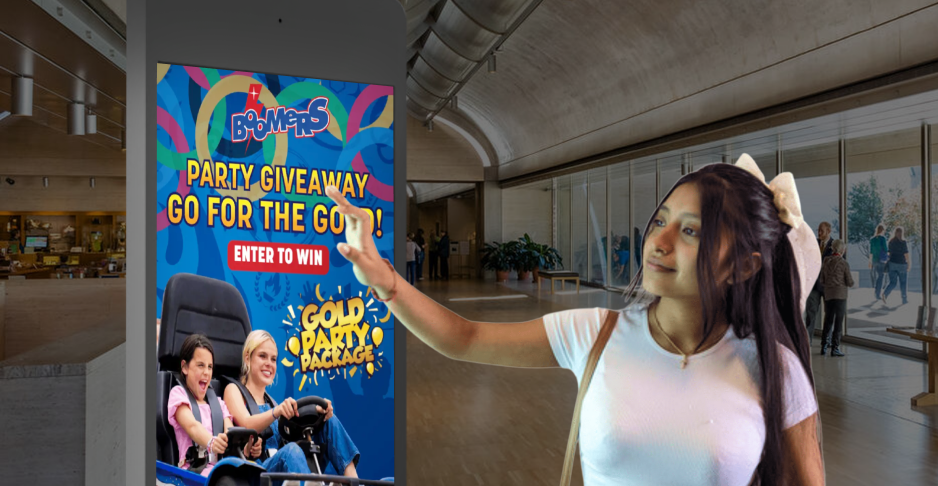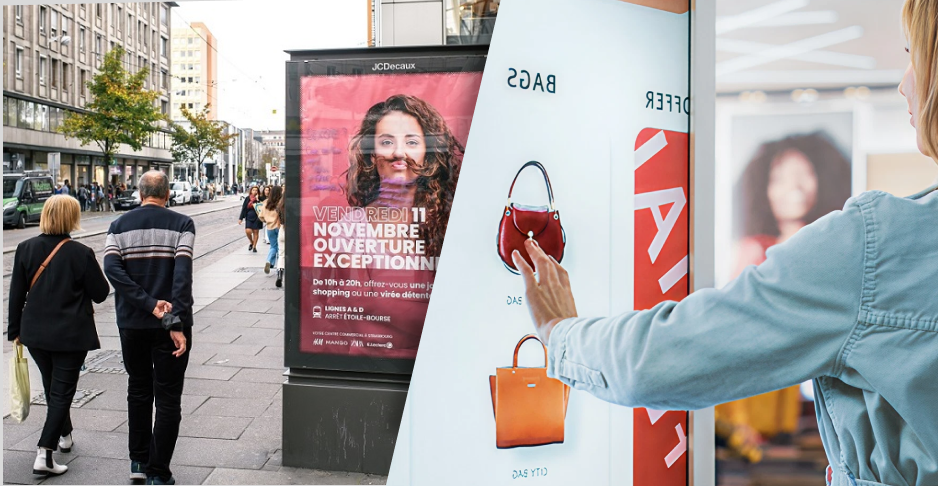The Battle for Eyeballs
In 2025, attention is currency.
Consumers walk through environments saturated with glowing screens—retail windows, billboards, transit stations, hotel lobbies, malls, airports, museums, even elevators. And yet, most of these displays are ignored. They play on loop. They broadcast generic content. They fade into the background.
Welcome to the great paradox of digital signage: more screens than ever, yet less impact per screen.
We’ve entered the attention economy, where the ability to capture and hold a consumer’s focus is more valuable than the message itself. And in this economy, traditional digital signage—flat, one-way, and passive—is losing ground.
But there’s a challenger gaining traction: interactive kiosks.
Smart kiosks, especially those powered by platforms like HootBoard, are proving to be dramatically more effective at engaging users, driving conversions, and generating data. In a world where passive messages get tuned out, interactivity is winning.
This article explores why most digital signage fails, why consumer behavior has shifted, and how interactive kiosks are outperforming in this new era of engagement.
The Harsh Truth: Static Screens No Longer Work
For years, digital signage was seen as the natural upgrade to traditional print ads and posters. And it was—at first. But over time, it became subject to the same downfall:
Oversaturation + lack of relevance = disengagement.
According to a 2024 Nielsen study, digital signage has just 1.5 seconds to capture attention in public environments. That’s shorter than a blink and barely enough for a message to register, let alone persuade.
The problem isn’t the medium—it’s the method.

Why Most Digital Signage Fails:
- It’s One-Way.
Most screens broadcast content with zero input from the viewer. It doesn’t matter who walks by—they see the same loop. That feels impersonal, irrelevant, and forgettable. - It’s Generic.
Without contextual triggers, signage ends up serving bland, “safe” content. That means lower recall, lower engagement, and zero interaction. - It’s Untargeted.
Unlike digital ads online, most signage doesn’t adjust based on time of day, audience type, location behavior, or previous user actions. - It Offers No Feedback Loop.
You can’t measure what people looked at, how long they stayed, or what they wanted to see more of. There’s no learning, no iteration, no optimization. - It Lacks Call-to-Action.
Static signage rarely converts. At best, it builds awareness. At worst, it becomes part of the noise.
In short, static digital signage is becoming the billboard of the 21st century—visible, but not truly seen.
Enter Interactive Kiosks: Engagement by Design

Now imagine a screen that doesn’t just talk—but listens.
A kiosk invites the user to touch, search, discover, and act. It’s no longer a passive message—it’s a conversation.
This fundamental shift—from broadcasting to interacting—is what makes kiosks exponentially more effective.
What Makes Interactive Kiosks Different?
- User-Initiated Engagement
Unlike signage that interrupts, kiosks invite participation. When someone walks up to a kiosk, they’ve opted in. That means the next 10–30 seconds are earned attention. - Personalized Experience
A kiosk can offer content relevant to that exact user—based on location, behavior, time, language, or preferences. - Two-Way Communication
Kiosks enable users to ask questions, browse options, leave feedback, and perform actions—making the experience memorable and functional. - Data Collection & Analytics
Every tap generates insights. You learn what content people care about, what they ignore, what times engagement spikes, and where drop-offs occur. - Real-Time Updates
Kiosks powered by cloud platforms like HootBoard can be updated instantly—meaning content stays fresh, seasonal, and hyper-relevant.
Numbers That Speak: Kiosks vs Static Signage
A HootBoard study conducted across 30 locations (spanning retail malls, tourism centers, and attractions) compared static digital signage to interactive kiosks using similar content. The results over a 60-day period:
| Metric | Static Digital Signage | Interactive Kiosks |
| Average Engagement Time | <2 seconds | 28.4 seconds |
| Content Interaction Rate | 0% (passive) | 68% |
| Email Capture/Lead Conversion | 0% | 18% |
| Bounce/Ignore Rate | 92% | 21% |
| Return Visit Rate (Same Location) | N/A | 24% |
That’s not just a marginal difference—it’s a complete paradigm shift in how environments engage with audiences.

Why This Matters for Retailers, DMOs, and Advertisers
🛍️ Retailers
In a mall, a kiosk isn’t just a map. It’s a discovery engine.
- Highlight in-store deals in real time
- Let shoppers filter by brand, product type, or occasion
- Collect preferences for personalized offers
- Enable loyalty sign-ups or coupon scans
Instead of broadcasting to a crowd, you engage one shopper at a time, with measurable ROI.
🌍 Tourism Boards (DMOs)
For DMOs, kiosks at airports, visitor centers, or transit stops become the first point of contact for travelers.
- Promote events dynamically
- Offer language-selectable content
- Let users create itineraries or get texted directions
- Track what neighborhoods or attractions generate the most interest
Instead of guessing what works, DMOs get real-time visitor intent data—crucial for campaign planning.
📣 Advertisers
For advertisers, kiosks open a whole new frontier:
- Contextual advertising (e.g., show food deals near me at lunch hour)
- Sponsored search results on local attractions
- Branded event promotions with lead capture
- Cross-promotions with QR code redemptions or app downloads
These are interactive, attributable ads—with trackable engagement metrics that static signage can’t offer.
Psychological Advantage: The Power of Agency
There’s a deeper, behavioral reason kiosks perform better: agency.
When users choose to engage—when they touch the screen, select a category, and navigate through options—they take ownership of the interaction. Psychologists call this the “IKEA Effect”—people value things more when they’ve contributed to them.
The same applies here: agency amplifies attention.
And in a world where consumer attention is fragmented and over-monetized, that agency is priceless.
Cost Efficiency: Kiosks Are No Longer Pricey Outliers
A common misconception is that kiosks are expensive compared to traditional signage. But costs have dropped significantly, and when you factor in their multi-functionality and ROI, the value is clear.
Let’s compare:
| Factor | Static Signage | Interactive Kiosk |
| CapEx | $1,000–$3,000 | $4,000–$6,000 |
| Content Management | One-way loop | Dynamic, on-demand |
| ROI Attribution | None | Full analytics dashboard |
| Conversion Capability | Zero | High (email, actions) |
| Monetization Potential | Low (maybe sponsor) | High (ads, upsells) |
| Utility | Brand awareness | Engagement + service |
In essence, a kiosk pays for itself—not just in impressions, but in actions.
What Makes a High-Performing Kiosk?
Not all kiosks are created equal. To succeed in the attention economy, kiosks must be:
- Fast: Instant load times and intuitive UI
- Relevant: Contextual content for time/place/user
- Adaptable: Easily updated based on campaign needs
- Measurable: Integrated analytics dashboards
- Scalable: Managed remotely across multiple locations
HootBoard checks all these boxes, making it one of the most agile and advertiser-friendly platforms in the market.
From Passive Screens to Performance Media
In a noisy, crowded, screen-saturated world, attention is no longer guaranteed—it must be earned.
Static digital signage is becoming background noise. Interactive kiosks, on the other hand, are emerging as performance-driven engagement tools. They capture attention. They spark curiosity. They invite action. And they deliver measurable, monetizable results.
Retailers, DMOs, and advertisers who embrace this shift aren’t just buying screens—they’re investing in touchpoints that talk back, in platforms that evolve, and in experiences that consumers remember.
The attention economy has new rules. Kiosks are built to play—and win—by them.




